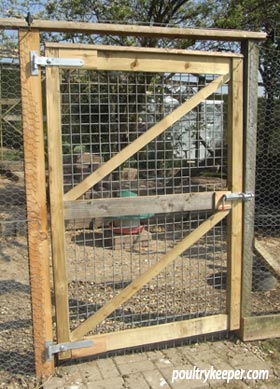Keeping a few chickens in the back yard really is quite straight forward; however there are some things to consider in order to get the right sort of birds for your situation and to keep them in the best possible health to get the most enjoyment out of keeping them.
This page hopes to get you thinking about the types of chickens and their requirements.
Choosing a breed
There are quite literally hundreds of different breeds of chicken to choose from and out of these, many have slightly different requirements.
Some breeds of chicken come only as Large Fowl, and others are also available as Bantams which are a smaller version that look the same. The Orpington for example is available in both large and bantam sizes but the Cochin is only available as large fowl.
There are a handful of ‘True Bantams’ where there is no large fowl equivalent. Examples of these are Dutch Bantams, Japanese Bantams and the popular Pekin Bantam.
Bantams tend to be quite flighty whereas the heavy breeds of large fowl often cannot fly more than a few inches off the ground. Orpingtons for example won’t usually roost very high due to their huge size and will usually just huddle on the floor of the coop.
Every breed is slightly different in the amount of eggs they lay. Typically hens that have been bred for exhibition purposes do not lay as well as utility hens. Bantams of course lay smaller eggs which some people say they prefer for taste.
Hybrids
 Hybrids are chickens that have been created by crossing pure breeds. They are typically crossed to make good layers (the hybrid to the right can lay 280 to 300 eggs!), coloured eggs or attractive hens. Some can be very attractive and they are all generally very hardy. Hybrids are produced in larger numbers that pure breeds and most of the crosses used make the males a different colour as day old chicks so that only females can be raised, therefore reducing costs by about half. A typical hybrid hen will cost you around £15 compare to £25 to £30 for a typical pure breed hen.
Hybrids are chickens that have been created by crossing pure breeds. They are typically crossed to make good layers (the hybrid to the right can lay 280 to 300 eggs!), coloured eggs or attractive hens. Some can be very attractive and they are all generally very hardy. Hybrids are produced in larger numbers that pure breeds and most of the crosses used make the males a different colour as day old chicks so that only females can be raised, therefore reducing costs by about half. A typical hybrid hen will cost you around £15 compare to £25 to £30 for a typical pure breed hen.
Hybrids are a good choice if eggs are one of your priorities although if you think you might like to hatch some eggs, remember hybrid hens do not breed true – you would need the original pure breeds to cross again in order to create more of the same thing so whilst you can hatch their eggs, you may want to consider a few pure breeds for this purpose or consider buying in eggs to hatch.
Free Range
You will of course need a chicken coop but also a secure run or area that is predator proof. A question that people always ask me is “How big should their run be?” I always say “as big as possible within reason.” Even 2 chickens kept in a 2 meter run will soon turn it to mud and get bored (which can introduce vices such as feather pecking and egg eating) but I always believe that it’s fine to provide a small run like this if you can let them out for a few hours each day to free range while you are around. This will give them a chance to forage, supplement their diet and reduce boredom.
Once chickens have settled into their new house, they will go back to it to roost every night so you can let them out in the late afternoon, knowing they will come back to roost at night keeping everyone happy! Some houses and runs have handles or wheels that make them easy to move onto fresh ground which is not only good to prevent a build up of worm eggs and disease but also provides them with a little fresh grass to graze.
Keeping Chickens in the Garden
If you have a ‘nice’ garden that you don’t want spoilt, it’s usually a sensible idea to limit their foraging. Chickens scratch at the ground, make dust baths in the dry soil, leave muck wherever they go and destroy tender young plants. If you can plant in pots, this will help and fencing off part of the garden is usually a good choice to keep them out if you have tender or precious plants. Chickens with feathered feet scratch less and bantams can clear a 6 foot fence if they want to. Heavy breeds of large fowl can be kept out with a knee high fence or box hedge. If you want to stop a bird from flying then you can clip one wing (not both).
So you have decided on the breed that’s right for you and your circumstances. Next, you will need to think about keeping them secure from predators in a suitable chicken house and chicken run – click on a link to go to that page!








My son is about to keep 3-4 chooks in the garden (in a coop) and as I have found this site useful I will recommend it to him.
I am interested in starting to keep some chickens but have no idea of where to start. I have an outbuilding in my back yard with a wooden door, but its not got any shleves of anything, its just brick built. What would i need to do to the outbuilding to get started. i’m a little bit lost. i would appreciate any advice.
Perches, nestboxes and a pophole to get in / out would be needed to get started.
Hi, when we got our chickens about 10 days ago, they were our first, we were advised to keep them in a” couple of weeks” to get used to the run as their own home before letting them out. Well, having built the coop and realising it was all wrong (when I read your pages, I learned a lot and modified it and they seem happier straightaway with dark nesting areas and several perches). This modification was done yesterday. I wonder what your opinion is as to how long they should be kept in the run before being let out free-range to forage and have fun – am just worried about losing them to the blue yonder as there are no fences around our place. Will recent modifications unsettle them massively such that they need to re-adjust? I’ve no idea how sensitive they are to alterations in their home etc. We’ve one cock, two hens, if it makes any difference, and the girls never seem to stray from the cock. Thanks, J
I’d keep them in for 2 or 3 days from new… and then let them out. Let them out initially a couple of hours before dusk so they don’t roam too far. Just be around at dusk to help them find their way back if necessary. They won’t usually go far and if they can’t find their coop will normally roost in a hedge or nearby in which case you will be there to guide them back before it is bed time.
After the first night or two, you’ll probably find them tucked up in bed. They soon learn. Some youngsters I hatch huddle up underneath a coop for a week or two if they aren’t used to a ramp and need lifting in but most hens will want to home to roost at dusk. I certainly wouldn’t keep them in now after the modifications, just start gradually and keep an eye and before you know it…
Just got 2 chickens amber & bluebell ,been in run for couple days now ,how soon can I let them out around garden ,seem to be settling ok ,thanks ,great site .
A couple of days should be fine. Let them out a couple of hours before dusk at first and they won’t go far. They should retun for bed but be around and then you can keep an eye.
Hi, love the site. I am wanting to start having about 4 hens. Could I put the coup and run along side some Conifer trees as there is a lot of soft ground from the needles and it gets the sun in the afternoon.
I don’t see why not 😉